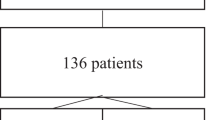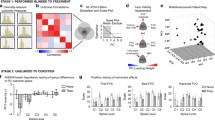Abstract
Purpose
To investigate the impact of early post-injury respiratory dysfunction for neurological and ambulatory ability recovery in patients with cervical spinal cord injury (SCI) and/or fractures.
Methods
We included 1,353 elderly patients with SCI and/or fractures from 78 institutions in Japan. Patients who required early tracheostomy and ventilator management and those who developed respiratory complications were included in the respiratory dysfunction group, which was further classified into mild and severe respiratory groups based on respiratory weaning management. Patient characteristics, laboratory data, neurological impairment scale scores, complications at injury, and surgical treatment were evaluated. We performed a propensity score-matched analysis to compare neurological outcomes and mobility between groups.
Results
Overall, 104 patients (7.8%) had impaired respiratory function. In propensity score-matched analysis, the respiratory dysfunction group had a lower home discharge and ambulation rates (p = 0.018, p = 0.001, respectively), and higher rate of severe paralysis (p < 0.001) at discharge. At the final follow-up, the respiratory dysfunction group had a lower ambulation rate (p = 0.004) and higher rate of severe paralysis (p < 0.001). Twenty-six patients with severe disability required respiratory management for up to 6 months post-injury and died of respiratory complications. The mild and severe respiratory dysfunction groups had a high percentage of severe paraplegic cases with low ambulatory ability; there was no significant difference between them. The severe respiratory dysfunction group tended to have a poorer prognosis.
Conclusion
Respiratory dysfunction in elderly patients with SCI and/or cervical fracture in the early post-injury period reflects the severity of the condition and may be a useful prognostic predictor.

Similar content being viewed by others
Data availability
The datasets generated during and/or analyzed during the current study are available from the corresponding author on reasonable request.
References
Anke A, Aksnes AK, Stanghelle JK, Hjeltnes N (1993) Lung volumes in tetraplegic patients according to cervical spinal cord injury level. Scand J Rehabil Med 25:73–77
Galeiras Vázquez R, RascadoSedes P, MoureloFariña M, MontotoMarqués A, Ferreiro Velasco ME (2013) Respiratory management in the patient with spinal cord injury. Biomed Res Int 2013:168757. https://doi.org/10.1155/2013/168757
Branco BC, Plurad D, Green DJ et al (2011) Incidence and clinical predictors for tracheostomy after cervical spinal cord injury: a national trauma databank review. J Trauma 70:111–115. https://doi.org/10.1097/TA.0b013e3181d9a559
Yugué I, Okada S, Ueta T et al (2012) Analysis of the risk factors for tracheostomy in traumatic cervical spinal cord injury. Spine 37:E1633–E1638. https://doi.org/10.1097/brs.0b013e31827417f1
Tanaka J, Yugue I, Shiba K, Maeyama A, Naito M (2016) A study of risk factors for tracheostomy in patients with a cervical spinal cord injury. Spine 41:764–771. https://doi.org/10.1097/brs.0000000000001317
DeVivo MJ, Chen Y (2011) Trends in new injuries, prevalent cases, and aging with spinal cord injury. Arch Phys Med Rehabil 92:332–338. https://doi.org/10.1016/j.apmr.2010.08.031
Miyakoshi N, Suda K, Kudo D et al (2021) A nationwide survey on the incidence and characteristics of traumatic spinal cord injury in Japan in 2018. Spinal Cord 59:626–634. https://doi.org/10.1038/s41393-020-00533-0
Cheung A, Thorogood NP, Noonan VK et al (2013) Onset, risk factors, and impact of delirium in patients with traumatic spinal cord injury. J Neurotrauma 30:1824–1829. https://doi.org/10.1089/neu.2013.2975
Ryken TC, Hurlbert RJ, Hadley MN et al (2013) The acute cardiopulmonary management of patients with cervical spinal cord injuries. Neurosurgery 72:84–92. https://doi.org/10.1227/NEU.0b013e318276ee16
Daneshvar P, Roffey DM, Brikeet YA, Tsai EC, Bailey CS, Wai EK (2013) Spinal cord injuries related to cervical spine fractures in elderly patients: factors affecting mortality. Spine J 13:862–866. https://doi.org/10.1016/j.spinee.2013.01.045
Schoenfeld AJ, Bono CM, Reichmann WM et al (2011) Type II odontoid fractures of the cervical spine: do treatment type and medical comorbidities affect mortality in elderly patients? Spine 36:879–885. https://doi.org/10.1097/brs.0b013e3181e8e77c
Majercik S, Tashjian RZ, Biffl WL, Harrington DT, Cioffi WG (2005) Halo vest immobilization in the elderly: a death sentence? J Trauma 59:350–356. https://doi.org/10.1097/01.ta.0000174671.07664.7c
Spivak JM, Weiss MA, Cotler JM, Call M (1994) Cervical spine injuries in patients 65 and older. Spine 19:2302–2306. https://doi.org/10.1097/00007632-199410150-00009
Furlan JC, Fehlings MG (2009) The impact of age on mortality, impairment, and disability among adults with acute traumatic spinal cord injury. J Neurotrauma 26:1707–1717. https://doi.org/10.1089/neu.2009.0888
Hirota R, Terashima Y, Ohnishi H et al (2022) Prognostic factors for respiratory dysfunction for cervical spinal cord injury and/or cervical fractures in elderly patients: a multicenter survey. Global Spine J 2022:219256822210954. https://doi.org/10.1177/21925682221095470
Kay ED, Deutsch A, Wuermser LA (2007) Predicting walking at discharge from inpatient rehabilitation after a traumatic spinal cord injury. Arch Phys Med Rehabil 88:745–750. https://doi.org/10.1016/j.apmr.2007.03.013
van Middendorp JJ, Hosman AJF, Donders ART et al (2011) A clinical prediction rule for ambulation outcomes after traumatic spinal cord injury: a longitudinal cohort study. Lancet 377:1004–1010. https://doi.org/10.1016/S0140-6736(10)62276-3
Newey ML, Sen PK, Fraser RD (2000) The long-term outcome after central cord syndrome: a study of the natural history. J Bone Joint Surg Br 82:851–855. https://doi.org/10.1302/0301-620x.82b6.9866
Greeenspan L, Mclellan BA, Greig H (1985) Abbreviated injury scale and injury severity score A scoring chart. J Trauma Injury Infect Crit Care 25(1):60–64
Engel-Haber E, Radomislensky I, Peleg K et al (2021) Early trauma predictors of mobility in people with spinal cord injury. Spine 46:E1089–E1096. https://doi.org/10.1097/brs.0000000000004053
Fawcett JW, Curt A, Steeves JD et al (2007) Guidelines for the conduct of clinical trials for spinal cord injury as developed by the ICCP panel: spontaneous recovery after spinal cord injury and statistical power needed for therapeutic clinical trials. Spinal Cord 45:190–205. https://doi.org/10.1038/sj.sc.3102007
Furlan JC, Noonan V, Singh A, Fehlings MG (2011) Assessment of impairment in patients with acute traumatic spinal cord injury: a systematic review of the literature. J Neurotrauma 28:1445–1477. https://doi.org/10.1089/neu.2009.1152
Acknowledgements
None.
Funding
No financial assistance was received.
Author information
Authors and Affiliations
Corresponding author
Ethics declarations
Conflicts of interest
The Authors declare that there is no conflict of interest.
Human participants and/or animals
We certify that all applicable institutional and governmental regulations concerning the ethical use of human volunteers/animals were followed during the course of this research. The institutional review board of a representative facility reviewed and approved this study (No. 3352–1).
Informed consent
Because this was a retrospective study, informed consent was not required for submission. The option to opt-out of this study was posted on the website, and we did not receive any inquiries.
Additional information
Publisher's Note
Springer Nature remains neutral with regard to jurisdictional claims in published maps and institutional affiliations.
Rights and permissions
Springer Nature or its licensor (e.g. a society or other partner) holds exclusive rights to this article under a publishing agreement with the author(s) or other rightsholder(s); author self-archiving of the accepted manuscript version of this article is solely governed by the terms of such publishing agreement and applicable law.
About this article
Cite this article
Hirota, R., Terashima, Y., Ohnishi, H. et al. Prognostic impact of respiratory dysfunction in elderly patients with cervical spinal cord injury and/or fractures: a multicenter survey. Eur Spine J 32, 3522–3532 (2023). https://doi.org/10.1007/s00586-023-07828-9
Received:
Revised:
Accepted:
Published:
Issue Date:
DOI: https://doi.org/10.1007/s00586-023-07828-9




